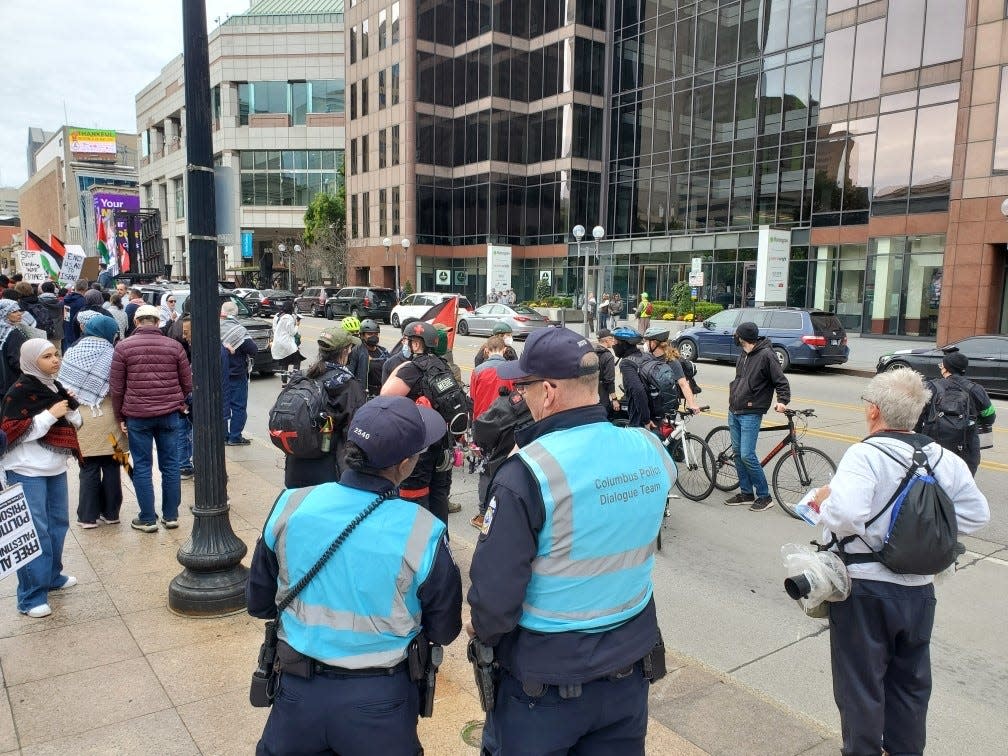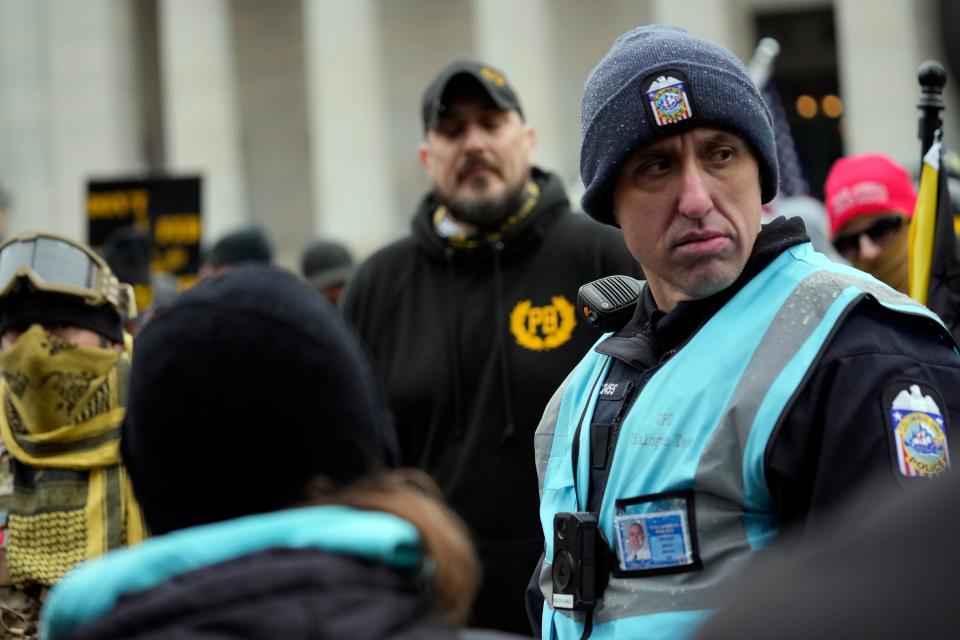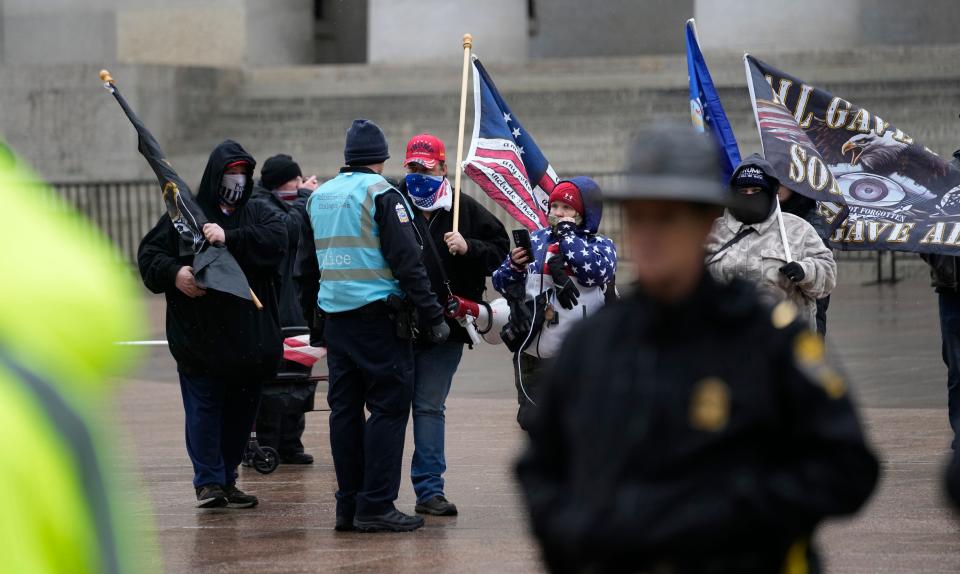After disgraceful 2020 protest response, Columbus police team now model for doing it right

In the wake of a mistrial in the case of a former Franklin County Sheriff's deputy accused of killing a Black man, nearly 100 people took to the streets in the Short North demanding justice.
Joining them along their route were a group wearing bright blue vests over their Columbus police uniforms. The officers stood off to the side, making sure everyone was able to share their thoughts peacefully.
For nearly four years, the shadow of the Columbus police response to 2020's protests and civil unrest has hung in the air at similar events. But a team of Columbus officers focused on encouraging dialogue has been working for the last two years to undo that damage.
Officers typically receive overtime pay when they attend protests as members of the dialogue team because most of the officers are doing the work outside of their normal job duties.
Members of the Division of Police's dialogue team have attended more than 100 protests, events and festivals each year with a goal of diffusing tensions and preventing situations from escalating to the point where a more forceful police response is needed.
The dialogue team in Columbus is the only unit of its kind in Ohio and one of only a few dialogue teams in the country. With more than 50 members, all who volunteered, Columbus has the largest dialogue unit in the country, Cmdr. Duane Mabry said.
Now departments around the country are looking to Columbus as a leader in how to better approach large-scale events and protests.
Mabry said the team also fields inquiries from agencies from coast to coast interested in learning more after Columbus police presented at a national police conference in 2023.
Dialogue team formed after judge said 2020 response 'ran amok'
In 2020, as protests swept the country in the wake of the death of George Floyd at the hands of Minneapolis police officers, activists, legal scholars a judge raised concerns about how Columbus police responded to protests here.
A group of protesters received a $5.75 million settlement after filing a lawsuit against Columbus police, the city spent hundreds of thousands of dollars investigating officer conduct and Ohio State University's John Glenn College of Public Affairs performed a post-incident analysis.
More: Read the John Glenn College of Public Affairs analysis
Some of the changes came about as a result of the lawsuit and an order from U.S. District Court Judge Algernon Marbely who said Columbus police "ran amok" in their response to the 2020 unrest. That order included restrictions on how Columbus police could engage with non-violent protesters, including limiting the use of pepper spray and wooden "knee knockers." The changes were later enshrined into law by City Council and Columbus police policy.

Mabry was one of the officers tasked with creating the plan for how responses would take place after Marbely's ruling. Mabry consulted with United Kingdom-based Clifford Stott, a leading expert in crowd psychology who consults with police agencies around the world.
Initially, Mabry said he was skeptical that someone who has never been a police officer, like Stott, could provide new insight on how to handle large crowds.
"What's this guy who's never had rocks and bottles thrown at him going to tell me about handling rocks and bottles," Mabry said of his initial thoughts. "Really, he got us to look at crowds differently."
Honest intent required: How dialogue works
Stott's approach uses updated science, Mabry said, that moves away from the traditional school of thought in the United States, including what Columbus police officers have been taught in their academy training. The "mob mentality" way of thinking has largely been discarded in Europe but remains part of Ohio's curriculum for police officers.
"Up until 2020, our police practice was built around that science," Sgt. Kolin Straub said. "That science has been debunked in Europe for decades."
Mabry also traveled to several European countries to learn about how protests are handled and policed in order to develop a plan for Columbus, learning from experts including security personnel who helped plan for protests at King Charles III's coronation in London.
That knowledge was then implemented by Mabry and Sgt. Steven Dyer to create training for 25 officers who volunteered to be part of the first members of the team. The unit has now more than doubled, Mabry said, with an additional training being held in April for other officers who will be joining.
Even though the Columbus unit has now been operational for nearly two years, Mabry said there is still lots of work to do to build trust, particularly with groups who are protesting police actions in Columbus or elsewhere.
"Honest dialogue requires honest intent," Mabry said. "We have to build relationships; we have to be seen over and over again. Our job is to be neutral and engage with everybody. Time, place and manner are what we're allowed to have a say in, based on the Constitution. We don't have a say on message."
Dyer said it's important for the community to understand that the dialogue team doesn't take sides on issues at protests they attend.
"You just don't listen," he said. "You look around and make sure nobody is there who doesn't belong."
The officers who are on the ground at an event are gathering information and passing it on to other officers in the area, Mabry said, but the information is not intelligence, which he said is an important distinction to be made. He said at one event, a group of protesters wanted to go to a location that in the past would have made police leaders nervous and likely would have resulted in force being used.
However, Mabry said dialogue officers talked with members of the group, who said they wanted to take a photo and then would leave, providing important context that allowed for a compromise.
Community slowly buying in to dialogue team's mission
Those types of interactions have helped people like the Rev. Willis Johnson, leader of Living Tree Church on the city's Northeast Side, buy into what the dialogue team is doing.
"Genuinely, I have seen, and I know from having experiences here and elsewhere, knowing there’s a resource for aid to make sure that First Amendment expressions are honored, there’s no doubt that’s valued and welcomed," Johnson said.
Johnson, who previously worked as a pastor in Ferguson, Missouri, while the city endured numerous protests, riots and the police department underwent a national review by the Department of Justice following the 2014 death of Michael Brown, said when he first encountered the Columbus police dialogue team, he was impressed with the approach.
"It was not just policing for policing's sake but rather looking at this as a means for greater community engagement and empowerment," he said.
Johnson said he has since worked with the dialogue team in trainings and as a resource to provide feedback and perspective for the team members.
But the road to community buy-in has been littered with speed bumps, most notably when Dyer high-fived a member of a far-right extremist organization that was protesting outside a Northwest Side church's holiday event that featured drag queens. The interaction, which came after the man complimented Dyer's mustache, was captured on video and went viral, drawing criticism.
Chief Elaine Bryant issued a statement after the video clip went viral that acknowledged the clip's optics weren't good, but that Dyer's intent was to "defuse a tense situation." She said at the time that the video would be used to help officers better understand how perceptions can impact the work of building relationships within the community.
"We're not always going to be successful," Dyer said. "We're going to make mistakes but we're trying really hard."
The effort is something Johnson said he and other members of the community, particularly the Black community, are seeing as well.
"While this might have emerged from or resulted from the responsibility of seeing how we do some things differently and responding to a reprimand or challenge, the spirit of this and continual practice has outlasted that initial, I think, reason or catalyst for it coming to bear. Now they are doing it because they want to," Johnson said.
Every one of the more than 50 officers who are currently on the dialogue team does that work in addition to their normal jobs. Joining the team is voluntary.
"They don't have to go out in a crowd and be yelled at and told profane things and told to go kill themselves and wish their families died and their kids were raped. That's the kind of things we hear," Mabry said. "That should say a lot to the community about what we're doing."
"Our goal is to get from 'F you' to 'thank you,'" Mabry said.
Dialogue teams part of larger trend in policing
Lt. Kiera Husband, who works with Columbus police recruits, said the concepts the dialogue team is focused on, particularly in de-escalation, are part of a larger conversation about policing that shifts away from strict enforcement.
"We have all these extra tools on our belts because dialogue doesn't always work, but your mouth is the strongest tool you will ever have," Husband said. "Everybody thinks we are the 'nice police,' but we are still the police. We don't give people freedom to break the law."
Straub said the initial group of officers who started the team were largely officers who joined Columbus police after 2020 and were not part of the lines who faced the most difficult days of unrest. But as more officers have seen the dialogue-led approach firsthand, the dynamic has shifted.

"We probably have the most diverse team in the division. We have straight, gay, Black, white, Christian, non-Christian, Muslim, atheist, we've got a little bit of everything," Mabry said. "When we engage these groups (at protests), they're likely engaging someone who's not too far off from them in some way."
Officers who join the dialogue team undergo 40 hours of training, including scenarios, education on the most up-to-date case law regarding First Amendment and protest actions, as well as conversations to practice skills to de-escalate and diffuse tensions.
"We want them to understand more about the protester mindset," Straub said. "We bring in activists who are willing to share."
bbruner@dispatch.com
@bethany_bruner
This article originally appeared on The Columbus Dispatch: How a Columbus police team became a model for its approach to protests

